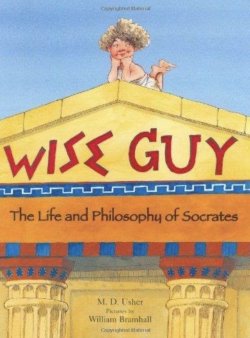Gareth B. Matthews

Review of Wise Guy: The Life and Philosophy of Socrates by M.D. Usher (New York: Farrar, Straus & Giroux, 2005). Originally published in Thinking: The Journal of Philosophy for Children 18(1): 3.
For many philosophers, and certainly for me, Socrates is a hero. He was executed in 399 BCE by a court of fellow Athenian citizens because he believed in his philosophical mission and refused even to try to appease the court by, say, promising not to corrupt the youth anymore. Wise Guy: The Life and Philosophy of Socrates is the story of the life and death of this philosophical hero something that might be made interesting to, say, a fourth or fifth-grader? One might reasonably be skeptical.
M.D. Usher’s biography of Socrates for children, humorously but also seriously illustrated by William Bramhall, makes the personality and idiosyncrasies of our philosophical hero bold, intriguing, and appealing. But most surprising of all, Usher manages to convey enough of the substance of the Socratic mission to give the reader some sense of what philosophy is.
Usher is a scrupulous scholar. He puts nothing in his story of Socrates except what he finds said about him in some ancient source. Inside the back cover of the book he documents his sources. Thus, for example, Socrates is said in the story to love to dance. And the illustrator offers a memorable illustration of Socrates, the dancer. Adult philosophers may be puzzled about where Usher got the idea that Socrates loved to dance. The notes at the back of the book point to the source, Xenophon, Symposium, 2.10.
The figure of Socrates in this biography is drawn primarily from the early dialogues of Plato, plus four middle dialogues, Phaedo, Symposium, Republic, and Phaedrus. Socrates is thus presented as having developed the Theory of Forms.
Here is one a passage in which Usher introduces readers to the Theory of Forms from Plato’s Republic:
What is an idea? Is it a thing you can smell, taste, or touch? If not, is it any less real than a bed or table? What is the difference between the idea of a bed and the bed itself? Socrates argued that the carpenter must have an idea or image of a bed in his mind before he can go about building one. But where does this idea come from in the first place? Socrates seems to have believed that objects in our world have an invisible eternal blueprint to which they correspond. The eternal blueprint of a bed may not seem so very interesting, but Socrates applied the idea to larger concepts, like right and wrong and good and bad. Just as a carpenter with vast knowledge and experience can make a good bed, and in turn be a good carpenter, a person who has studied the blueprint of right and wrong can be a good person.
This bit of Platonic metaphysics is introduced with an appealing illustration of a carpenter being observed and puzzled over by a young child. It is not hard to imagine that a good class discussion, or a good discussion around the dinner table, might take off from the notion of blueprints, including the important, but perplexing, idea of “eternal blueprints.”
There are other goads to philosophical reflection in the story, such as the Allegory of the Cave from Plato’s Republic. And some goads to reflection are one-liners, such as this one: “It is better to suffer a wrong than to commit one.” Can that be right?
The story ends with the thought that the friends of Socrates “have been asking questions ever since [his death].” Some of those “friends of Socrates” are presented in delightful caricature on the next-to-last page of the book, namely, Erasmus, Jefferson, Kierkegaard, Nietzsche, Gandhi, Russell, Wittgenstein, Arendt and Martin Luther King. Each “friend” gets a thumbnail sketch.
As we professional philosophers know only too well, explaining to anyone, young or old, what philosophy is, and why it is important, is a daunting task. This appealing biography of Socrates is a splendid effort at trying to make it less daunting. An added bonus is the very real possibility that, not only the children in a class at school or in a family, but also their teacher or parent might gain some new appreciation for Socrates and philosophy from reading and taking in the illustrations from this fine book.
